 |
 |
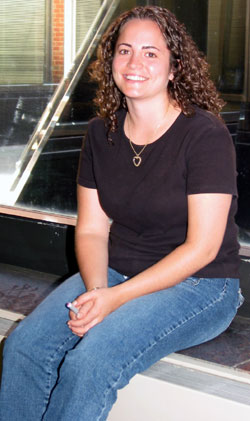
|
|
Abby Vogel, M.S., National Institute of Child Health and Human Development (NICHD), National Institutes of Health (NIH)
|
1. I chose the career because...
2. My typical workday involves...
3. Equipment I use in my work...
4. What I like best/least about my work …
5. My career goals are...
6. When I'm not working, I like to...
|
|
1. I chose the career because...
|
Back to Top

|
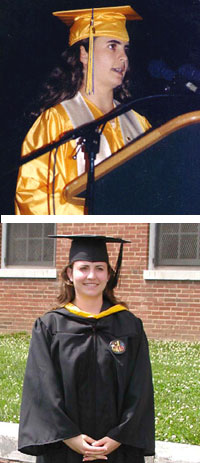
|
|
Abby Vogel's high school graduation in 1998 (top) and receiving her Master's degree in 2004 (bottom)
|
I chose to become a bioengineer because it was a perfect combination of my love of the biological sciences, and my desire to solve complex problems, analyze information, and write and edit scientific material. When I was a senior in high school, my teachers told me that I should be an engineer, because I excelled in math and science. It sounded good to me at the time; since all I knew about engineers was that they made good money. During my first semester at the university, I took the course, Introduction to Engineering Design. After that, I realized engineers had to work hard to earn a degree. There were many types of engineering specialties to choose from, but bioengineering was, by far, the most interesting to me.
Continuing My Education
After receiving a bachelor’s degree, I continued my education. The thesis research for my master’s degree was performed at the NIH. I used non-invasive imaging techniques to study the effects of radiation on skin. Fibrosis, or skin hardening, is a major side effect that may be induced by the radiation therapy used to treat cancer patients. By better understanding the effects of radiation on the skin, we could help cancer patients who are undergoing radiation therapy and develop fibrosis. Currently, I work for the NICHD in the Laboratory of Integrative and Medical Biophysics and am working towards my Ph.D.
Education
- Bachelor of Science, Biological Resources Engineering, University of Maryland
- Master of Science, Biological Resources Engineering, University of Maryland
- Doctor of Philosophy, Biological Resources Engineering, University of Maryland (current student)
|
|
2. My typical workday involves...
|
Back to Top

|
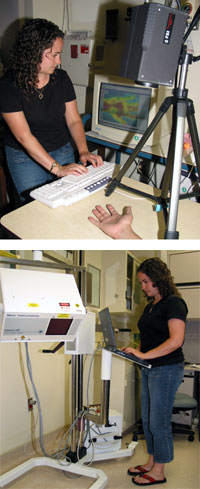
|
|
Abby Vogel uses a thermal camera to view the image of a human hand (top) and prepares the Laser doppler imager before a patient's arrival (bottom).
|
My typical workday involves my own research, and the work our lab does for two major clinical trials underway at the NIH Clinical Center.
We collaborate with the National Cancer Institute (NCI) on two clinical trials that involve innovative drug therapies for patients with Kaposi’s Sarcoma (KS) and Reflex Sympathy Dystrophy (RSD). KS is a type of cancer that affects the skin and mucous membranes and that can spread to other major organs in the body. RSD is a nerve disorder that simultaneously affects the nerves, skin, muscles, blood vessels, and bones. For both studies, our laboratory performs non-invasive imaging techniques that help us to evaluate the patient’s response to the therapeutic drugs.
My major tasks are to:
- Plan and perform laboratory experiments for a research project and thesis necessary to obtain my Ph.D.
- Perform non-invasive imaging techniques for patients (with KS and RSD) in clinical trials
- Edit all scientific papers that originate in my lab section for publication in professional journals
- Manage the procurement of laboratory equipment and supplies
|
|
3. Equipment I use in my work...
|
Back to Top

|
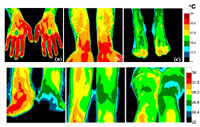
|
|
Abby Vogel compares thermal data between a normal volunteer (top) and a patient (bottom).
|
Our laboratory research relies on the data we obtain from the following non-invasive imaging devices:
- Thermal Camera – a camera that provides a two-dimensional image of superficial skin temperature. Higher temperatures occur in the skin superficial to veins that are involved in the transport of blood.
- Laser Doppler Imager – a device that utilizes a low-power laser beam to produce a two-dimensional image of blood velocity over a defined area. The images correspond well to a physician’s visual assessment (i.e. tumor size is often defined visually) and certain results may be associated with disease.
- Near-infrared Multi-spectural Imager – a device that captures images at six wavelengths in the near-infrared waveband. The spectral data is used to reconstruct local variations in the concentrations of analytes in the skin, as well as, total blood volume.
|
|
4. What I like best/least about my work …
|
Back to Top

|
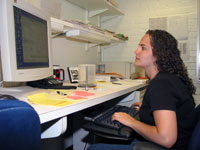
|
|
In addition to her long hours conducting research, Abby Vogel spends a great deal of time writing her Ph.D. thesis.
|
What I like best about my work is contributing to the clinical trials, and working in a clinical setting. I enjoy meeting the patients and watching them improve week to week.
What I like least about my work is the long hours it takes to conduct research, while also working on writing my thesis for graduate school. Earning my master’s degree definitely prepared me for the research and time required to pursue a Ph.D.
|
|
5. My career goals are...
|
Back to Top

|
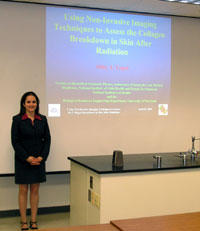
|
|
Abby Vogel defending her Master's thesis.
|
My career goals are to graduate with a Ph.D. in Biological Resources Engineering and to publish as a first author in a leading professional journal. I have co-authored two papers, presented an oral presentation at a national conference, and presented at five poster sessions. After graduating with a Ph.D., I am undecided about whether to pursue a career in academia as a professor, or in industry as a biomedical engineer.
|
|
6. When I'm not working, I like to...
|
Back to Top

|
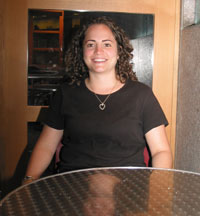
|
|
| |
Abby Vogel takes a rare break in the fellows lounge of the NIH Clinical Center.
|
When I’m not working, I am still heavily involved in organizations at the University of Maryland. As an undergraduate, I became involved in the university senate. I have served on many senate committees during the past three years including the Senate Executive Committee, Student Affairs Committee, and Nominations Committee. This culminated in 2003 when I was selected as the chair of the Student Affairs Committee. I am also involved in graduate student engineering organizations at the university, including the Engineering Graduate Student Council (EGSC) and the Biological Resources Engineering Graduate Association (BREGA).
|
|
|
|
 |